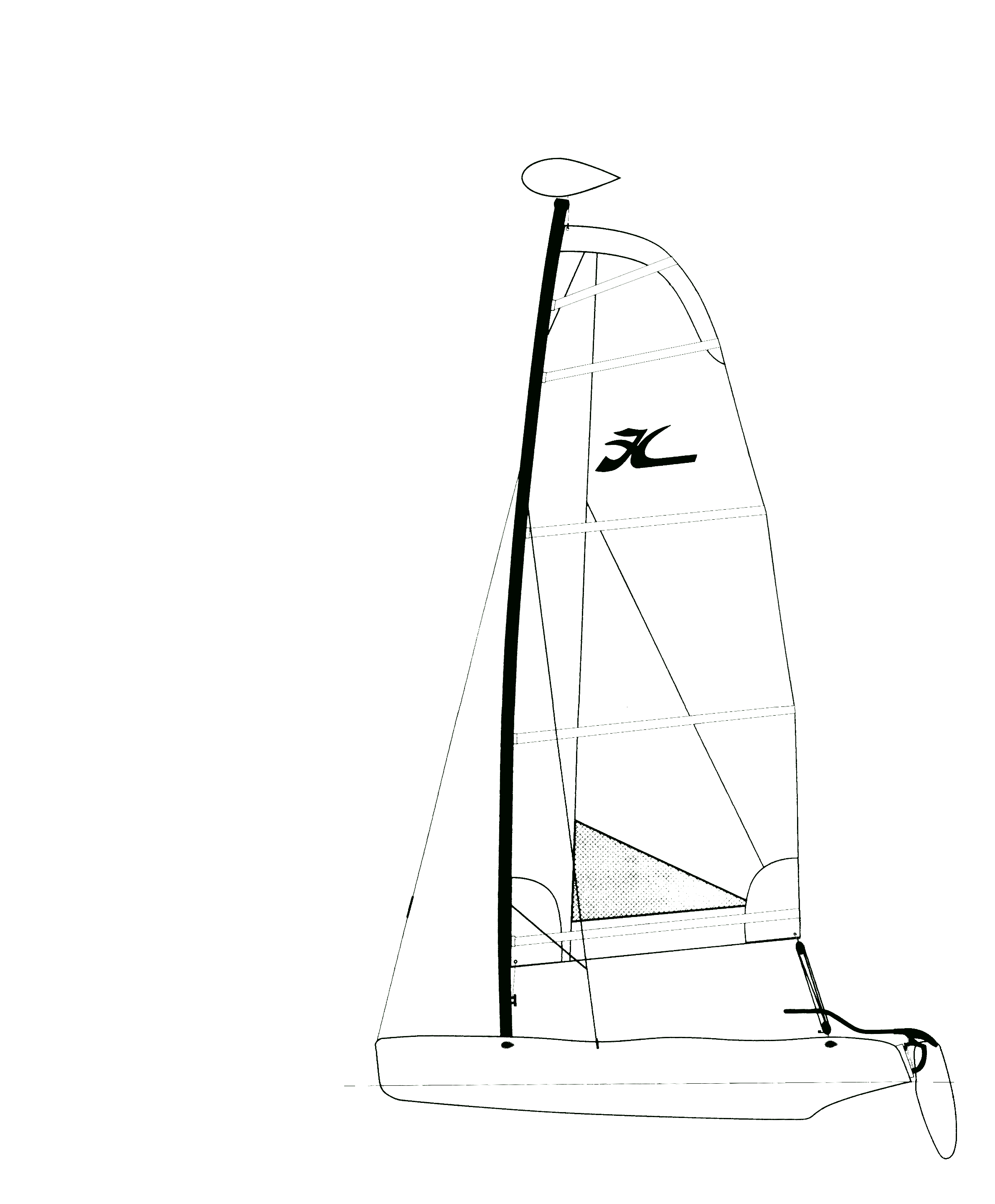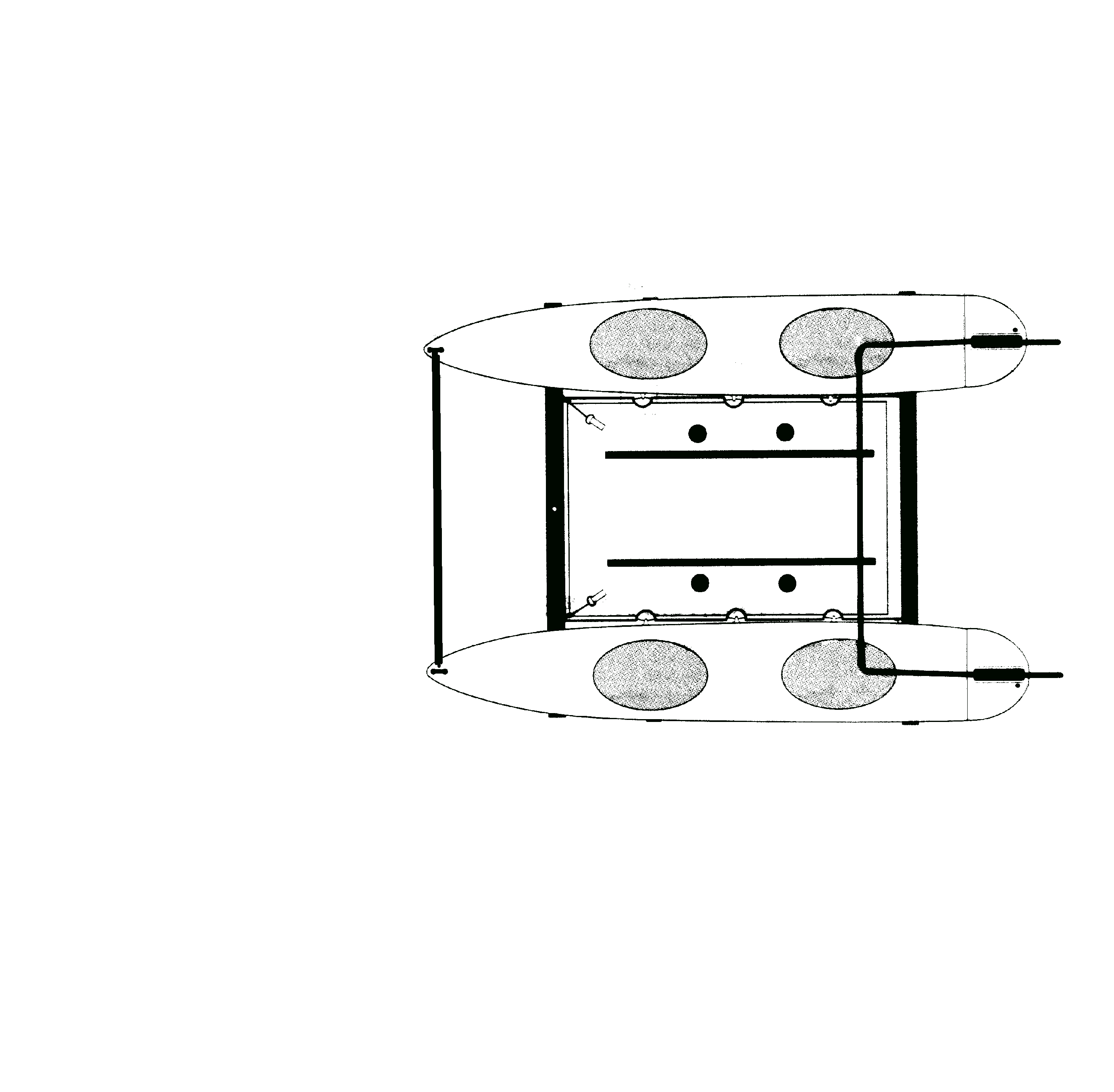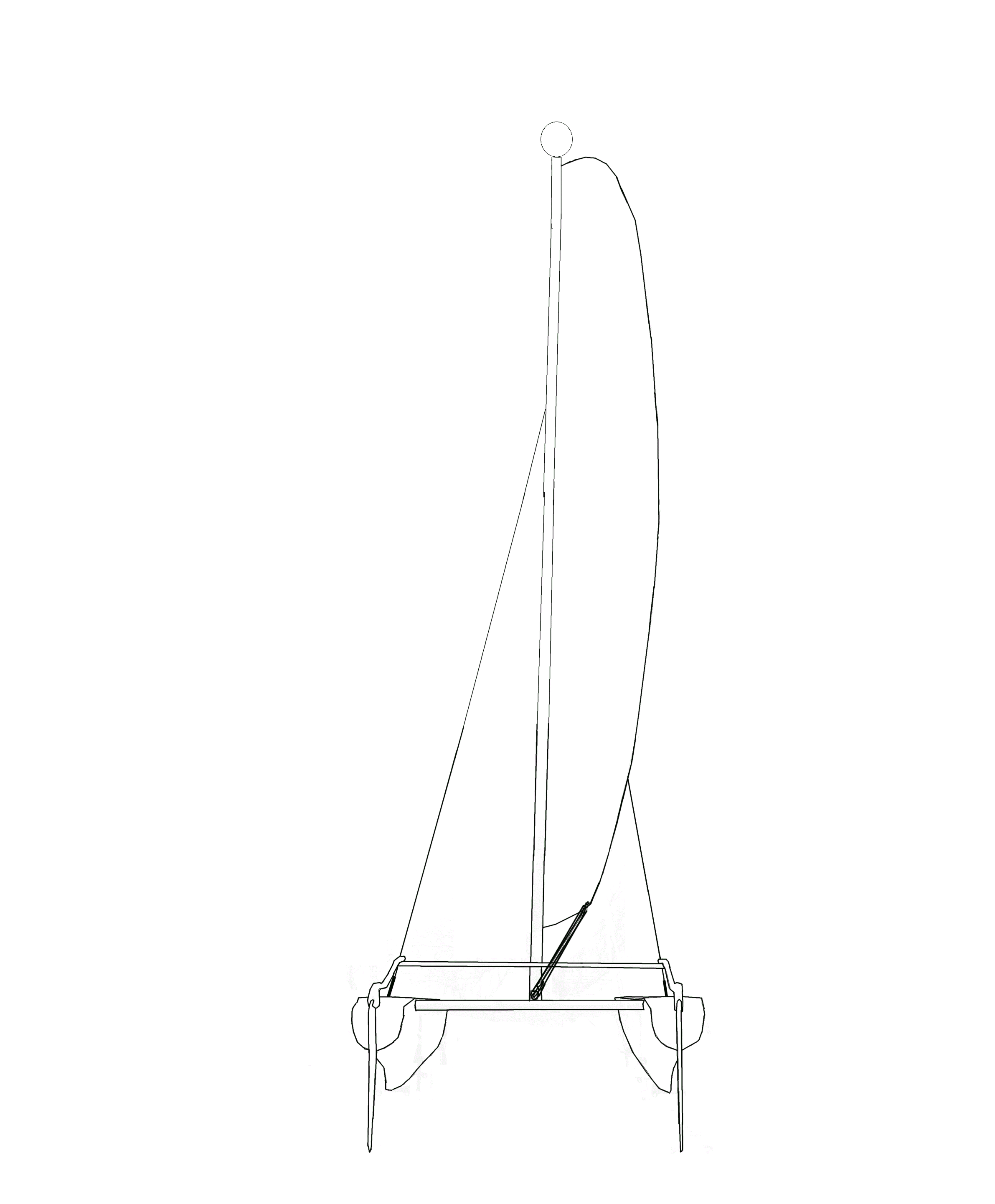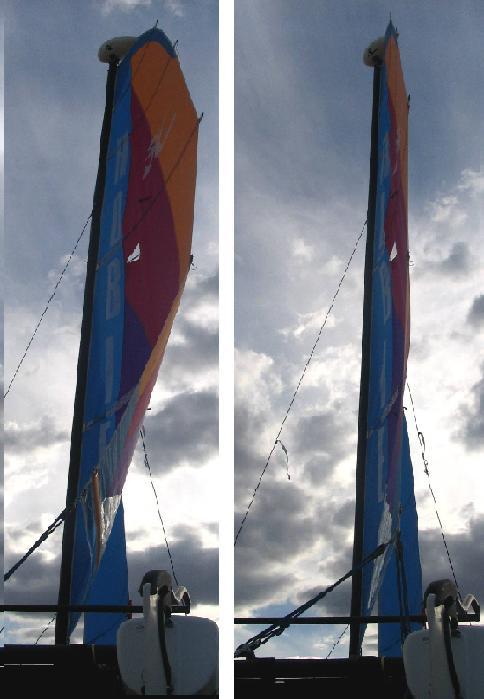
Hobie Wave
Modifications, Add-ons, Upgrades,
Enhancements, and Other Tinkerings
Messing about with small boats includes customizing them to suit yourself and improve performance. If you've messed with your Wave, here's the place to let others know about it and for you to get ideas you may not have thought of yet.
Traveler
Reefing
Jibs
Spinnaker/Reacher
Sail slides
Quick release pins
Cat Tracks
Cruising your Wave
Motors and mounts
Seats
Sliding seats
Back rests/wings for the do-it-yourselfer
Center board
Float vane
Mast rotation control
Human power options
Travelers
Travelers allow you to control main sail twist, which is especially important on the cat rigged Wave (although I do have the jib kit Hobie sells--the 25 ft2 jib, marginally useful, can be seen in the photos below). As the following photos show, excessive twist greatly reduces mail sail efficiency. On the left, with only the main sheet attached to the center of the aft crossbar, you have no way to control twist when sailing on a reach. The foot ends up pulling excessively while the top luffs.
Adding track and a traveler car, as is found on most sail boats, would be possible, although it would be an expensive and problematic mod since the track would have to be raised to allow clearance for the Velcro tramp straps. Rope travelers may be old fashioned, but would be one solution for the Wave. Adding two vangs gives the same functionality without requiring any alterations whatsoever. The picture on the right shows a vang being used to take excessive twist out of the main sail.


The eye straps used to tension the tramp could be used as attachment points for the vangs, which would be the same size as the mainsheet: two fiddle blocks, one with cam, and perhaps snap shackles for quick set up and take down. The two vangs could share a common line so that as line comes out of one, the other takes it up avoiding excessive amounts of line on the tramp.
Although one vang would be enough if the main sheet were moved to the opposite side, there are advantages to leaving the main sheet block in place. Releasing both vangs, you can tack or gibe as usual using the main sheet for simple control, then after things settle down on your new point of sail you can trim the main with the appropriate vang. In strong winds, you really want the main sheet to take up most of the load, as only two vangs would be put under high stress when sailing close hauled.
Below: The rigging of the boomless stock Wave. The 35' main sheet is 5/16" fuzzy line. The Ronstan fiddle block (Series 40, 41530 all-purpose, no bearings) with the cam is 4 5/8" not including the shackle and the other fiddle is a Series 40 41500. But the system is strong enough and matching 4:1 vangs with 75' of 5/16" line would also be strong enough. Consider adding half-turn safety shackles or snap shackles and new main sheet line when you get the vangs. If you want to upgrade the main blocks, get another Ronstan set to match the stock blocks, then get new, more comfortable to handle, 3/8" line (Ronstan Series 50 or Harken) fiddle blocks for the main sheet. (The halyard shackle on the clew below was added just to attach the experimental vang--a bow shackle might work better as an attachment point for the vangs and main sheet.)

Reefing
Getting caught in a rising wind should be of concern. You can pinch the wind and sail with the main largely depowered and luffing, but if capsizing is not on the list, getting back to port can become a bit more challenging than it should be. Without the ability to reef in the main, you may find yourself staying within sight of the car, or worse, having a really bad day. In Mexico we sailed our Hobie 16 about 3 miles along the coast to explore a large estuary, and on our way out and back found ourselves having to beat into a ripping wind. Fortunately the 16 had reef points in the main and we made it back. The point is I wouldn't want to repeat the experience in a Wave without a reefable main, and I don't want a boat I can't do a little exploring in. Wind happens and you have to be prepared for it. Even on a day sailor used only on lakes, reefing is essential.
The easy fix is to take your sail to a sail maker and say, "reef points please." Since I live in Arizona, that's not so easy. Sailrite.com offers kits for home sail makers. They have a Jiffy Grommet ($3.50 ea.) that you can hammer on that should be all that's needed for the inter reef points, and for the clew and tack short pieces of strapping could be stitched on for added support. You would just carry some extra lines to go through the eyes to reef the sail the old fashioned way. One set of reef points would be good, a second set even better. Nine of the grommets would put in two sets of reef points.
Another idea is to add nylon straps for reefing. I have some thin, strong strapping used to pull wire through conduit. My idea is to make a slit near the bottom edge of the next batten up, run the strap in, up over the batten, down, and out the other side, then hand stitch in place. To avoid flop, the straps could be velcroed flat to the sail. Untying the straps, however, would be more difficult than if using line.
Hobie mentions patented zipper reefing as an option, but I have been unable to find anything out about it. I suspect it was an early option that was discontinued. At this point I'm leaning towards using the Jiffy Grommets for a traditional solution for the do-it-yourself type. Optional, but nice, would be to replace the mostly rope halyard with a wire/rope halyard with stops swaged on for each reef point. Wire up the mast makes for less windage than rope.
Jibs
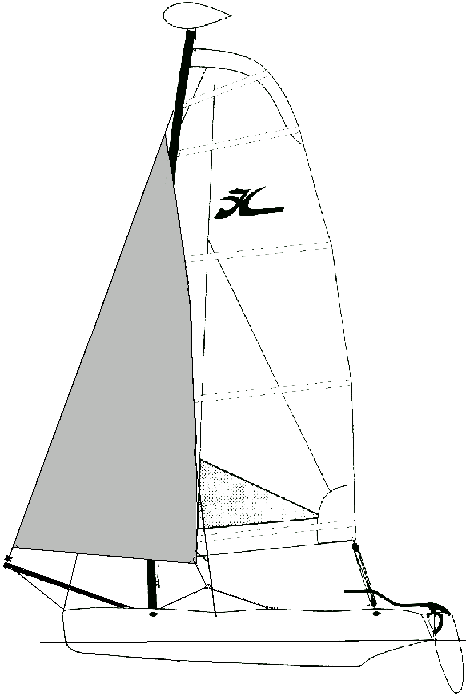
On a cat-rigged boat, do you need a jib? Not if there's enough wind to go as fast as you want, and not much wind is needed for the Wave to go fast. You also don't need a jib to backwind to help come about when tacking as the Wave tacks nicely with just the main. The problem with the 25 ft2 jib Hobie offers is that it's not needed if you have wind, and it's too small to help much in light winds. There is only a narrow range of wind speed where it could be useful and so often isn't worth the trouble to rig. Adding a headsail to a Wave makes sense only in light winds, and then only if it's big enough to do you some good. But light air sailing can be some of the best sailing if you have the sails for it. You shouldn't have to sit on the beach waiting for the wind to pipe up.
I happen to have an extra Hobie 16 jib, so I hoisted it to see if it could be made to work. The jib, twice the area of the Wave jib, seems about the right size to significantly improve windward performance in light winds. The sail is made to be used with battens and is heavier than needed, so it's not ideal. I'm also thinking a working jib for a Wave should be on roller furling supported by a jib halyard so after it's rolled up it could then be dropped and stowed to get rid of any weight and windage aloft, and so it could simply be left on shore on windy days--up and down and off shouldn't take more than a couple of minutes.
The existing forestay would require modification to shorten to bridle to lessen the angle and lower the attachment point. The only thing needed for the stay, apart for swages and swaging tool, would be a new, longer wire for the forestay. Of course there was a reason for the long bridle--it puts more force up on the bows than a bridle with a flatter angle. Unlike the fiberglass hulls, the Wave's plastic bows will deform inward if pulled together. The solution is to put an aluminum pole between the bows (one is provided with the jib kit) to brace them.
The Wave jib kit has the jib attaching to the bow crossbar. For a larger headsail you would need to add a bow spirit, about 4-5 feet long, going from the hull crossbar below the mast, out above the bow crossbar, and stayed with a wire bridle bracing it from the bows. The jib kit has a cam cleat with fairlead mounted on the inside hull at about midpoint of the tramp. Pulling the jib sheet from here doesn't allow for proper trimming of the jib. Adding another set of cams to the foreword crossbar near the hulls with line leading to snatch blocks attached to the jib sheets would allow you to trim the jib without adding track down the hull. You could put track on the crossbar to allow the snatch block to pull from different angles.
Spinnaker/Reacher
In light air, on a reach, what you want is a really big head sail that would serve as a large genoa/drifter on a close reach and more like a spinnaker on a broad reach, something like that used on the
Super Wave. Roller furling such a deep sail seems messy, and you really don't want all that sail, even furled, aloft when you're not using it. Using a stuffer, as done on the Hobie Dragoon (a European Wave in fiberglass, with mast stepped back and head sails added), might be the better option. Either way, take a look at both systems.Run the spinnaker halyard all the way to the top, extend the bow spirit, and add some blocks. Something like:
Under construction....
Drawings to sketch your ideas on (right click on and Save Picture As)
